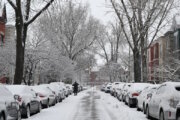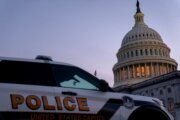Deciding whether to send a child to public or private school can be a tough choice for parents of elementary, middle and high school students. Data on whether public or private education is better can be challenging to find and difficult to understand, and the cost of private school can be daunting.
So how can parents weigh private schools versus public schools?
Myra McGovern, spokesperson for the National Association of Independent Schools, says it really comes down to what is best for each child.
“The individual needs of the child should shape the choice for parents,” she says.
Robert Pianta, dean of the School of Education and Human Development at the University of Virginia, says parents should be “clear about the specific benefits that they are seeking for their child.”
“What is it about their child that makes them think a private education will be better, and then, more importantly, what is it about a specific private school that matches that child’s needs?” he wrote in an email. “And then, would this experience (or others) be also available in public school?”
Public and Private Schools By the Numbers
With more than 13,000 public school districts and more than 30,000 individual private schools in the United States, parents certainly have plenty of choices.
[READ: Is Private School Tuition Tax Deductible?]
According to the most recent data from the National Center for Education Statistics, public schools still attract far more students than private schools, with 50.7 million students attending public school as of 2018. Private school enrollment in the fall of 2017 was 5.7 million students, a number that is down from 6 million in 1999.
But what are the distinctions that might make a difference to parents as they decide between the two? Experts and education researchers say parents should look at a variety of factors when choosing a school for their child including:
— Educational outcomes, such as rates of graduation and college enrollment.
— Class size.
— Teacher training.
— Affordability.
— Diversity.
— Availability of programs for learning disabilities.
Comparing Student Success in Public and Private Schools
Research has consistently shown that private school students tend to perform better in standardized tests. The National Assessment of Educational Progress, which is often referred to as “the nation’s report card,” assesses both public and private school students in subjects such as math, reading, science and writing. The most recent NAEP data shows what other research has found: Private school students score better in almost all subjects.
On college entry tests such as the SAT, NAIS found that students in private schools consistently out-performed their public school peers in all subject areas.
While private schools appear on paper to promise better educational outcomes for their students, some scholars have attempted to dig deeper than just test scores to find out if private schools actually increase student success.
Pianta, who led a study published in 2018 that examined academic, social, psychological and attainment outcomes, says he found student success is more directly related to family attributes, such as having college-educated parents and higher incomes, than which school they attend.
“When you compare children who went to private school (for an average of six years) with those who only went to public school, any apparent benefits of private schooling — higher test scores, for example — are entirely attributable to parents’ education and income,” he says. “The fact that they went to private school does not account for any differences we might see.”
Christopher Lubienski, a professor at Indiana University and co-author of the book, “The Public School Advantage: Why Public Schools Outperform Private Schools,” agrees, saying, “Whether it’s a public or private school is not necessarily the defining factor. Private schools tend to score better on tests. … But we found that family background differences more than explains the difference between public and private school test scores.”
It’s no secret that private school students tend to come from families who have higher incomes and more education. But what about students from low-income families who attend a private school?
Megan Austin, a senior researcher at the American Institutes for Research, looked at the success of students who participated in Indiana’s publicly funded private school voucher program, which is aimed at students from lower socioeconomic backgrounds and skews heavily toward the parochial schools that participate in the voucher program.
[Read: First Day of School — What Parents, Teachers Should Know.]
She says that students using vouchers to attend private schools were somewhat less successful than those who were attending without a voucher, but that “both types of students … were less likely than traditional public school students to ever fail a course, or to ever be suspended in high school, and they were more likely to enroll in college within one year of high school graduation.”
Courses and Class Size
When researching school options, parents also may want to consider what kinds of courses public and private schools offer, particularly in high school, where high-achieving students may want access to a varied selection, including honors and Advanced Placement classes, Austin says.
She adds that parents should ask schools about how many students graduate on time, how many of their students enroll in college, and the school’s average SAT and ACT scores, among other things.
“Those are all indicators that have been shown to correlate with later success, so asking for that information is a good starting point,” she says.
Class size may be another indicator for parents. While the conventional wisdom of the past few decades has been that smaller class sizes are always better for students, Pianta says research on the impact smaller class sizes have on student success has actually been mixed.
“It’s only when classrooms are in the 12-18 (student) range of size compared with classrooms of 25-35 (students) that we really see a difference,” he says. “In fact, although those smaller classes are observed to be richer in interactions and conversations, there is also some evidence to suggest that some larger classrooms (25-30) actually are better managed, and children learn somewhat more in terms of facts.”
But Pianta also stresses that, when it comes to class size, “there’s not a clear rule of thumb.”
Still, the selling point of private schools for many parents is smaller class sizes and more individualized instruction. NCES data indicates that the average private school has about 166 students, while the average public school has about 526. The student-to-teacher ratio at private schools was 11.9 students per teacher, lower than the average 16.2 at public schools.
McGovern of NAIS says smaller class sizes in private schools create a “more tight-knit environment,” which allows the “teacher to really get to know each individual student and their strengths and weaknesses.”
Pianta agrees that smaller class sizes may benefit certain types of children. “If parents have a real reason to be concerned about their child in a large classroom (perhaps that student is very shy or, on the other hand, more likely to be disruptive), then smaller classrooms are better,” he says. But he adds that many public school classrooms boast less than 20 students per class, which would allow the same kind of individualized attention students receive in private schools.
Teacher Training and Certification
Regardless of class size, parents may want to look at the certification, training and professional development obligations of teachers in both public and private schools.
McGovern acknowledges that many private school teachers are not certified as public school teachers are required to be, but she emphasizes that private schools often want to hire subject matter experts with advanced degrees who can give students more authoritative instruction than a teacher with a background in just education. “Independent schools generally have extensive professional development for individual teachers and groups of teachers to make sure their skills in the classroom are really top-notch,” she says.
McGovern also says independent schools “are not driven by performance on standardized tests,” as many public schools are, giving teachers more flexibility in creating engaging curricula. However, she acknowledges that, because some private schools don’t teach with standardized testing in mind, it can make it more difficult for those schools to document the benefits of their approach.
Lubienski says teacher certifications are important. Public school teachers face rigorous requirements to attend training and to adopt the latest changes in curricula for important subjects like math. Without certifications and regular professional development, curricula can become outdated.
The Cost of Public vs. Private Schools
Public schools are funded by taxpayer dollars, but private schools represent an additional expense for parents. To send their children to private schools, parents generally either need to have the resources in hand to pay tuition or they need some type of financial aid, whether that is scholarship money, loans or publicly funded vouchers in states and localities that offer them.
[READ: Process Art for Kids: What Parents Should Know.]
The average annual tuition for private K-12 schools was $12,350 as of August this year, according to EducationData.org. However, tuition can vary substantially by locale. For example, in Connecticut, the average annual cost of tuition, $23,980, is almost double the national average. In Wisconsin, the average annual cost, $3,550, is less than one-third the national average.
Cost can also vary based on the type of private school. For example, schools operated by organizations like the Roman Catholic Church or other religious groups tend to cost less than secular independent schools. For example, the national average for high school tuition is $16,040, while the average Catholic high school cost is $11,240, according to EducationData.org.
Diversity in Public and Private Schools
Private schools are sometimes criticized for a lack of racial and ethnic diversity, and it is true that 67% of students attending private schools were white in 2017, according to the NCES. Only 11% were Hispanic, 9% were Black, 6% were Asian, and the remaining 7% were a mix of students from biracial, Pacific Islander or Native American backgrounds.
Many private schools have made great strides to increase racial and ethnic diversity in recent years. However, education experts say diversity in private schools can be curated and less organic than in public schools.
Pianta says parents looking to send their children to schools with a diverse student body are more likely to find that in public schools. “The diversity of public school is a strength,” he says.
Best Schools for Learning Disabilities
For children with learning disabilities, education experts say that private schools may not always be a good fit.
Public schools are required by law to provide access to “a free appropriate public education to eligible children with disabilities throughout the nation and ensure special education and related services to those children,” according to the U.S. Department of Education’s webpage on the Individuals with Disabilities Education Act, or IDEA. The department says 7.5 million children were receiving services in public schools under IDEA as of the 2018-19 school year.
Pianta says his research shows children with learning disabilities are better off in public schools, given the resources that states and localities are required to commit under the IDEA.
“Public schools are more tightly regulated than private schools, and this is very evident in the services they must provide to students with special needs,” Pianta says.
McGovern of NAIS acknowledges that not all private schools have support systems for children with learning disabilities, but emphasizes that “some schools do a phenomenal job with students of different learning abilities.”
Indeed, some private schools specialize in instruction for children with learning differences. For example, The Fletcher Academy in Raleigh, North Carolina, notes on its website that it serves students “with ADHD, processing & memory issues, and a variety of learning disabilities, including dyslexia, dysgraphia and dyscalculia.” Similarly, the Forman School in Litchfield, Connecticut, is a college prep school for children with ADHD and dyslexia.
“It’s important for families to ask what the school’s strengths are and their capabilities to really serve the child based on his or her unique needs,” McGovern says.
Researching Public vs. Private Schools
Because each child is different and school options vary by locality, many experts say parents need to do their research locally before deciding what’s best.
“People often assume that private options are better in areas like transportation, housing and health care,” Lubienski says. “With education, that’s not necessarily true.”
He says parents may want to choose private schools over public schools for reasons that go beyond academic outcomes, such as religious education or extracurricular activities such as sports, music or theater.
Austin, of the American Institutes for Research, says parents should evaluate a variety of options in their communities, including public charter and magnet schools.
“Many parents name academic quality as their top priority, but fewer parents end up having a strong understanding of the academic quality of the school their student goes to,” Austin says. “Instead, they tend to rely on reputation, word-of-mouth or less concrete information that may or may not actually reflect school quality.”
Searching for a school? Explore our K-12 directory.
More from U.S. News
How Much Does Private School Cost?
Choosing a Summer Camp for Your K-8 Child
Private School vs. Public School originally appeared on usnews.com







